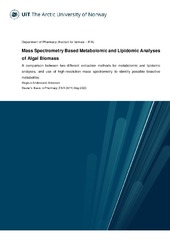Mass Spectrometry Based Metabolomic and Lipidomic Analyses of Algal Biomass.
Permanent lenke
https://hdl.handle.net/10037/29467Dato
2023-05-14Type
MastergradsoppgaveMaster thesis
Forfatter
Antonsen, Magnus AnderslandSammendrag
Background: In a project at UiT - the Arctic University of Norway, the lipid profile of the
microalgal biomass from the specie Porosira glacialis is mapped using HRMS lipidomic
analyses to evaluate the potential for the biomass to be used as fish feed. At the same time, it is
desired to screen the same biomass for bioactivities using bioassays in combination with HRMS
metabolomic analyses. The two processes use two different extraction methods. To evaluate
the differences between the extraction methods, a comparison between one of each extract was
done in this thesis. Fractions from extracts are also tested for bioactivity and analysed on HRMS
to initiate the mapping of bioactivity.
Method: Microalgal biomass of P. glacialis was extracted using two different extraction
methods, yielding an aqueous, an organic and a lipid extract. The metabolic and lipidomic
profile of the organic and the lipid extract was compared using HRMS metabolomic and
lipidomic analyses. The aqueous and the organic extracts were fractionated using flash
chromatography, before being tested for various bioactivities and analysed using HRMS.
Observed activity was investigated and a potential bioactive compound was isolated and tested
for anti-cancer activity.
Results: There were no obvious differences in the metabolomic and lipidomic profiles between
the organic and the lipid extracts, but some trends could be observed. The lipidomic analyses
showed low lipid detection not consistent with previous research, which needs further
investigation. In fractions obtained from the microalgal biomass from P. glacialis, anticancer
activity against human melanoma A2058 cancer cells and growth inhibition against the bacteria
Streptococcus agalactiae were observed, as well as anti-inflammatory activity in an ELISA
immunoassay. An isolated potential bioactive compound showed no activity against human
melanoma A2058 cancer cells at five different test concentrations.
Conclusion: None of the extraction methods can be considered favourable over the other based
on the comparison in this thesis. Various bioactivities were observed for fractions derived from
the microalgal biomass of P. glacialis, but more investigation must be done to identify the
compounds responsible for the activity.
Forlag
UiT Norges arktiske universitetUiT The Arctic University of Norway
Metadata
Vis full innførselSamlinger
Copyright 2023 The Author(s)
Følgende lisensfil er knyttet til denne innførselen:


 English
English norsk
norsk
